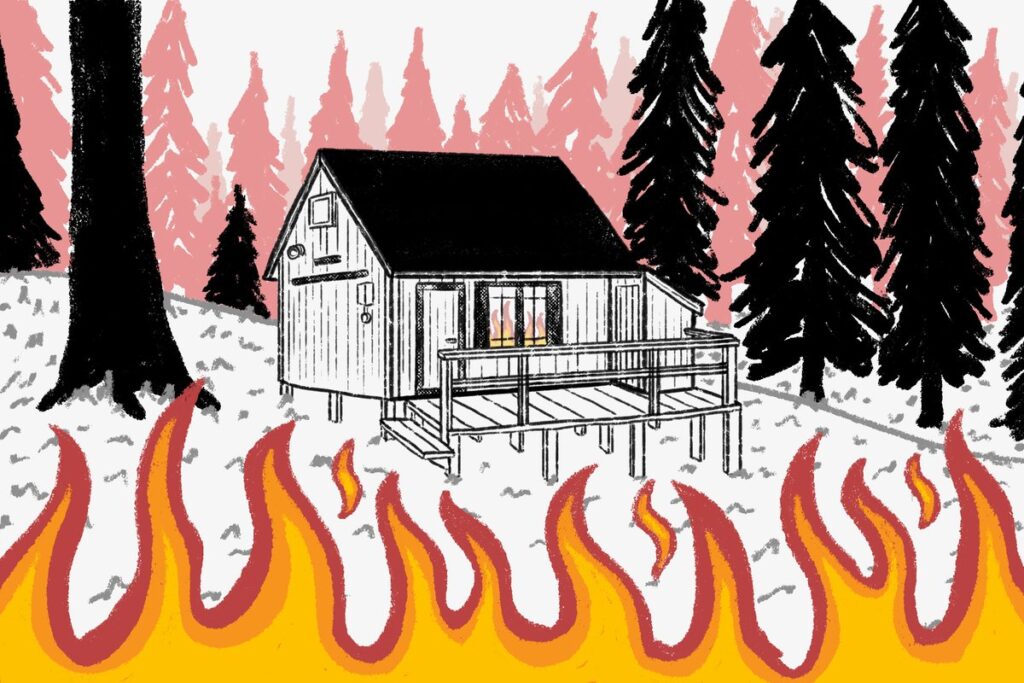Printed in the High Desert Advocate Edition September 17, 2021.
… This is the story of one of them

By Julie Brown
The last time Wendell Ward went to the cabin his father built in 1941, he vacuumed the carpet and mopped the floor. He was planning to return to the small red cabin in the woods a week later on Labor Day, and so he cleaned the cabin before he left, as he had always done.
Ward had been following the daily updates of the Caldor Fire closely. His family’s cabin, built in Phillips, a half hour drive southwest from Lake Tahoe, was one of dozens of old-timey homes nestled in the trees just off Highway 50 near Sierra-at-Tahoe ski resort — and in the direct path of the fire. Still, when Ward left the cabin, he thought the fire was holding steady, that it wouldn’t travel this far. But just in case, he took the log books that had documented the cabin’s entire history, with records from nearly every visit by his family. He also took the ashes of his nephew, who had loved this cabin dearly before he died.
Among the things Ward left behind was a blanket. It belonged to his grandmother. Gray wool with letters stitched in red thread that spelled the name of a long-shuttered lumber mill: Caldoor. It’s short for California Door Company, a lumber mill that sourced its wood from a logging town called Caldor.
On Sunday, Aug. 29, the Caldor Fire surged, driven by winds, and made its advance up to the crest of the Sierra Nevada. That day, the fire burned more than 20,000 acres in 24 hours. Sierra-at-Tahoe fired up its snowmaking guns and sprayed down all of its buildings in hopes of protecting the ski resort. Along Highway 50, from Twin Bridges to Echo Summit, dozens of small cabins in the woods owned by generations of families hardly stood a chance against the hot, raging flames.
There were more than 50 cabins in Ward’s neighborhood in Phillips. Three remain standing.
The Caldor Fire, which is now more than 50% contained, has burned almost 218,000 acres and destroyed 778 homes, many of them in Grizzly Flats, a community in El Dorado County that the fire swept through in its initial days. That number could have been much higher if thousands of firefighters hadn’t arrived just as the flames entered the Lake Tahoe Basin. Remarkably, the homes in South Lake Tahoe were saved. Still, in addition to hundreds of full-time residences that burned to ashes in Grizzly Flats, many mid-century cabins tucked into the woods in Phillips and at Echo Lake did not survive.
The structures were more than summer retreats. For the families that built them, and cared for them, and passed them down from one generation to the next, these cabins were family heirlooms.
The grief comes in waves, Ward’s daughter Krystle Lynn Yue told me. Yue has been coming to the cabin since she was born. When I spoke to her on the phone, just days after the cabin burned, she was just beginning to process the loss. I could feel the rawness of her emotions, even on the phone.
“It’s like grieving a person,” Yue said. “It was just this constant in our lives.”
Ward, who is 63 years old, is also grieving the loss.
“It happened so suddenly and so violently,” he said.
Ward lives in Diamond Springs, a small town near Placerville. It’s the same town where he was born and raised, and where his father grew up, too. In the first half of the 20th century, logging and lumber were big industries in this region. The California Door Company operated a sawmill in Diamond Springs and shipped timber in from the logging town of Caldor in the Eldorado National Forest. Ward says the lumber train used to run through his property, and he still finds railroad spikes when he’s mowing the lawn.
“It was a huge company in my day,” Ward said, “and it had a lot to do with my life.”
The Ward family cabin was 80 years old when it burned. In a twist of irony, the cabin’s life is marked at its beginning and its end by Caldor.
In 1929, Ward’s grandfather was killed on the railroad that connected Caldor to Diamond Springs and was used to transport lumber. After her husband died, Ethel Maude Ward Meyers (she went by Maude) purchased a half acre of land on the Phillips tract.
In the summer of 1941, Maude’s son, Sydney, who is Wendell’s father, built the cabin with his brother-in-law. The cabin was built with lumber from Caldor.
The cabin was originally built as a garage, just large enough to park a Model T Ford. Sydney intended to build a summer home alongside the cabin, but history took a radical turn when the United States entered World War II. The following year, on the day after he graduated high school, Sydney enlisted in the Army and fought in Europe.
After the war, when Sydney returned, he decided to forgo the larger house. Instead, he converted the garage into a small living area with a loft, adding a kitchen and a small bathroom.
The cabin was just 262 square feet. Yue told me about wicker rocking chairs they kept on the small porch all summer. Come winter, snow would pile up, sometimes burying the cabin itself. The loft was big enough for two beds, a queen and a twin. Downstairs, a single room encompassed the couch and a dining table. Yue said she’d open up the windows on both sides of the cabin to let the breeze flow in.
Wendell was too young to remember his first visit to the cabin, but in the log books that he rescued from the fire, there’s an entry his mom recorded about bringing her 7-week-old son up there.
“It was just the most peaceful place in the world,” Wendell said. “If some member of our family or friends had a terrible tragedy …that’s where you went.”
About 11 years ago, when Ward’s wife was battling cancer, they went to the cabin while she recovered from chemotherapy. They’d let their dogs run around in the woods. The South Fork of the American River runs around the back of their property. As generations of family members grew up, they marked their heights on a particular wall inside.
“Everybody took naps in the cabin,” Ward said.
When the Caldor Fire made its run up the crest and into the Lake Tahoe basin, officials repeatedly said the fire was burning with extreme intensity. Based on the aftermath, Ward agrees. After the fire destroyed his cabin and burned through Phillips, he went up to see what remained.
“I wanted to see with my own eyes,” he said. “It is absolutely a moonscape. I had an aluminum shovel, a snow shovel and a regular shovel leaning against the cabin. The shovel handles, of course, are burned up. The steel regular shovel is warped all to heck. The aluminum is vaporized. It is not there.”
Now, Ward and his extended family are trying to figure out their next steps. The matter of how to rebuild is complicated. The cabin was so old and featured many homemade accoutrements — like renegade electrical wiring with screw-in fuses and no breaker panel — Ward said they weren’t able to insure it. Information about permitting, about rebuilding the water system, about modern-day codes is still hard to come by, and he’s hoping to learn more at an El Dorado County emergency meeting on Friday. Ward said the mood is tense in Diamond Springs right now. The small town is full of fire refugees who lost their homes in Grizzly Flats.
“Considering my father’s life, this is a walk in the park,” he said. “I can’t feel sorry for myself. I can’t allow myself or anyone to become a victim. That would be so disrespectful of my parents’ life, as hard as they worked. I just have to figure out how to do this.”

